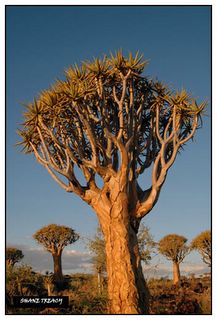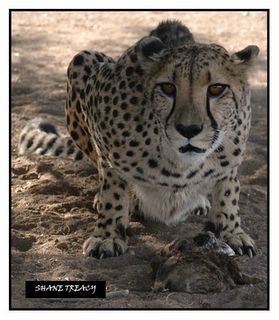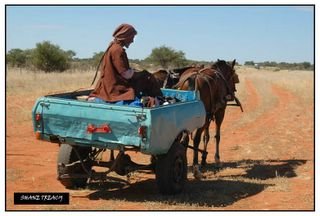Sunday, March 06, 2005
SOCIABLE WEAVER HOME

SOCIABLE WEAVER HOME
A common sight on the road south. These birds live often more than 100 per tree, hence the name. If you get a chance ask Alvina what she thought the nests were.
The nest acts as an insulator against freezing winter nights. As the night air drops dramatically from 63 degrees F to freezing, an occupied chamber in a large nest never falls below 61 degrees.
Despite their dropped-haystack appearance, the structures have a sophisticated architecture, with different materials for different purposes. The birds interlock large twigs to form the strong roof and wedge dry grasses into the insulating bulk of the nest. A breeding pair lines the cup inside its nest chamber with soft grass flowers and other fluffies, and uses green grass to mold a firm ridge at the lip of the cup that will keep eggs from rolling out. The tunnel that leads down from each chamber is armed with sharp spikes of straw that make reaching into a nest a painful experience.
Their nest-building instinct is so strong that when no new chambers are needed, they will fill in a perfectly usable chamber and build a new one below it. The largest nests extend well over 20 feet from side to side and several feet high, containing more than 100 individual chambers. Sometimes, the weight of the giant nests breaks branches and even knocks down entire trees.
The birds use cooperative breeding, when an individual other than mom or dad helps to incubate eggs and feed chicks. Weavers will frequently build a nest chamber to be used by others. Non-siblings will help a breeding pair despite a surplus of nesting space where they could raise their own young. If one pair loses its own brood, the couple may even start providing food for the neighbors' family.
The weavers' primary reptilian enemies are the boomslang and the Cape cobra who could wipe out a colony in one sitting.
DANCING AT HOACHANAS

DANCING AT HOACHANAS
We stopped at the township of Hoachanas and were entertained by great singing and a bit of dancing.
Hoachanas is a small village at the edge of the Kalahari in Namibia, approx. 200km south of Windhoek. The country is dry and is suitable only to limited agriculture. In the mid 19th Century the first groups of the Nama settled here. But already in the 18th Century the area was an important meeting place of the traditional leaders.
In 1853 the Rheini mission created a small mission station in Hoachanas and between 1857 and 1863 developed a brick church, one of the first in Namibia, which possessed a bell tower. In order to give to the Nama basic training, a mission school was established.
Today Hoachanas has a population of 2000. Unemployment, poverty and AIDS are problems.
DAY 4
We were picked up from our lodge at 8am.
Our guide was Thys and he had two trainee's, Sindy and Henny. One other couple made up our tour, Tom and Sheila.
Left Windhoek in mini van and head south towards Keetmanshoop.

Stop off at township of Hoachanas, listen to some great singing and watch traditional dancing.
After lunch we continue to our destination, the campsite at Kokerboom Forest, north of Keetmanshoop.
Our guide was Thys and he had two trainee's, Sindy and Henny. One other couple made up our tour, Tom and Sheila.
Left Windhoek in mini van and head south towards Keetmanshoop.

Stop off at township of Hoachanas, listen to some great singing and watch traditional dancing.
After lunch we continue to our destination, the campsite at Kokerboom Forest, north of Keetmanshoop.













